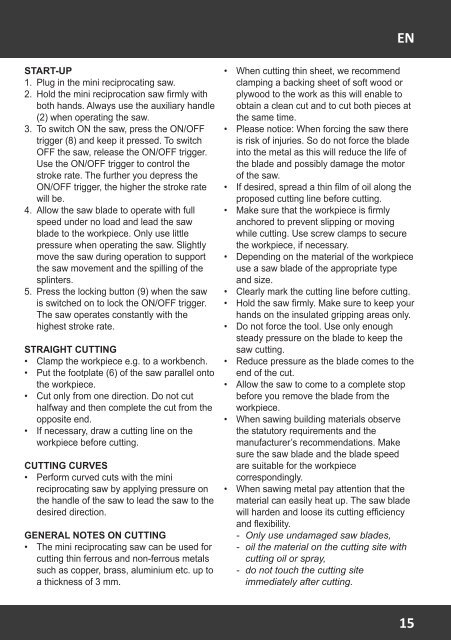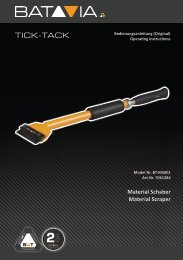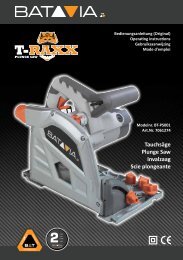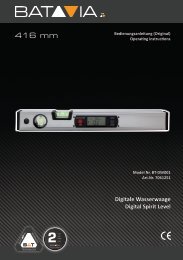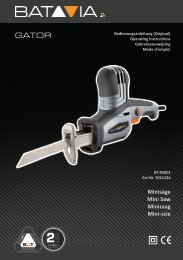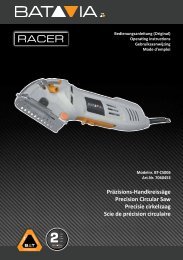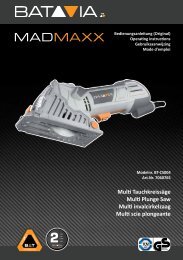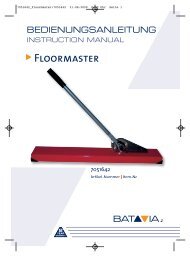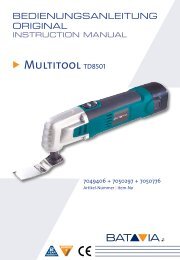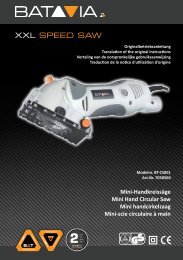Manual GATOR Mini-Saw
You also want an ePaper? Increase the reach of your titles
YUMPU automatically turns print PDFs into web optimized ePapers that Google loves.
EN<br />
START-UP<br />
1. Plug in the mini reciprocating saw.<br />
2. Hold the mini reciprocation saw firmly with<br />
both hands. Always use the auxiliary handle<br />
(2) when operating the saw.<br />
3. To switch ON the saw, press the ON/OFF<br />
trigger (8) and keep it pressed. To switch<br />
OFF the saw, release the ON/OFF trigger.<br />
Use the ON/OFF trigger to control the<br />
stroke rate. The further you depress the<br />
ON/OFF trigger, the higher the stroke rate<br />
will be.<br />
4. Allow the saw blade to operate with full<br />
speed under no load and lead the saw<br />
blade to the workpiece. Only use little<br />
pressure when operating the saw. Slightly<br />
move the saw during operation to support<br />
the saw movement and the spilling of the<br />
splinters.<br />
5. Press the locking button (9) when the saw<br />
is switched on to lock the ON/OFF trigger.<br />
The saw operates constantly with the<br />
highest stroke rate.<br />
STRAIGHT CUTTING<br />
• Clamp the workpiece e.g. to a workbench.<br />
• Put the footplate (6) of the saw parallel onto<br />
the workpiece.<br />
• Cut only from one direction. Do not cut<br />
halfway and then complete the cut from the<br />
opposite end.<br />
• If necessary, draw a cutting line on the<br />
workpiece before cutting.<br />
CUTTING CURVES<br />
• Perform curved cuts with the mini<br />
reciprocating saw by applying pressure on<br />
the handle of the saw to lead the saw to the<br />
desired direction.<br />
GENERAL NOTES ON CUTTING<br />
• The mini reciprocating saw can be used for<br />
cutting thin ferrous and non-ferrous metals<br />
such as copper, brass, aluminium etc. up to<br />
a thickness of 3 mm.<br />
• When cutting thin sheet, we recommend<br />
clamping a backing sheet of soft wood or<br />
plywood to the work as this will enable to<br />
obtain a clean cut and to cut both pieces at<br />
the same time.<br />
• Please notice: When forcing the saw there<br />
is risk of injuries. So do not force the blade<br />
into the metal as this will reduce the life of<br />
the blade and possibly damage the motor<br />
of the saw.<br />
• If desired, spread a thin film of oil along the<br />
proposed cutting line before cutting.<br />
• Make sure that the workpiece is firmly<br />
anchored to prevent slipping or moving<br />
while cutting. Use screw clamps to secure<br />
the workpiece, if necessary.<br />
• Depending on the material of the workpiece<br />
use a saw blade of the appropriate type<br />
and size.<br />
• Clearly mark the cutting line before cutting.<br />
• Hold the saw firmly. Make sure to keep your<br />
hands on the insulated gripping areas only.<br />
• Do not force the tool. Use only enough<br />
steady pressure on the blade to keep the<br />
saw cutting.<br />
• Reduce pressure as the blade comes to the<br />
end of the cut.<br />
• Allow the saw to come to a complete stop<br />
before you remove the blade from the<br />
workpiece.<br />
• When sawing building materials observe<br />
the statutory requirements and the<br />
manufacturer’s recommendations. Make<br />
sure the saw blade and the blade speed<br />
are suitable for the workpiece<br />
correspondingly.<br />
• When sawing metal pay attention that the<br />
material can easily heat up. The saw blade<br />
will harden and loose its cutting efficiency<br />
and flexibility.<br />
- Only use undamaged saw blades,<br />
- oil the material on the cutting site with<br />
cutting oil or spray,<br />
- do not touch the cutting site<br />
immediately after cutting.<br />
15<br />
7061234 Ma # 1112-16.indd 15 16-12-11 13:31


